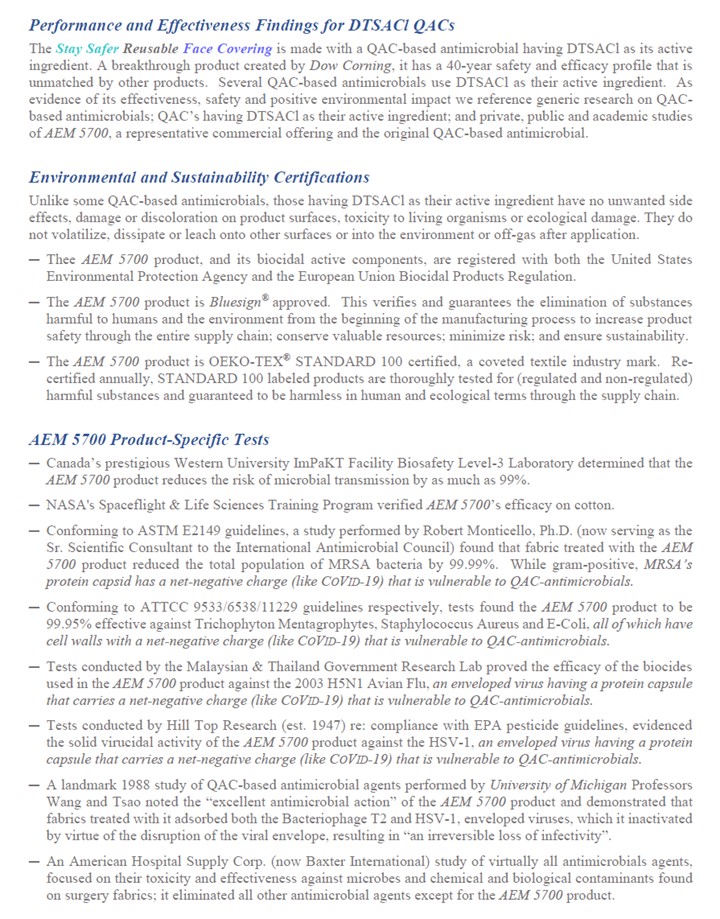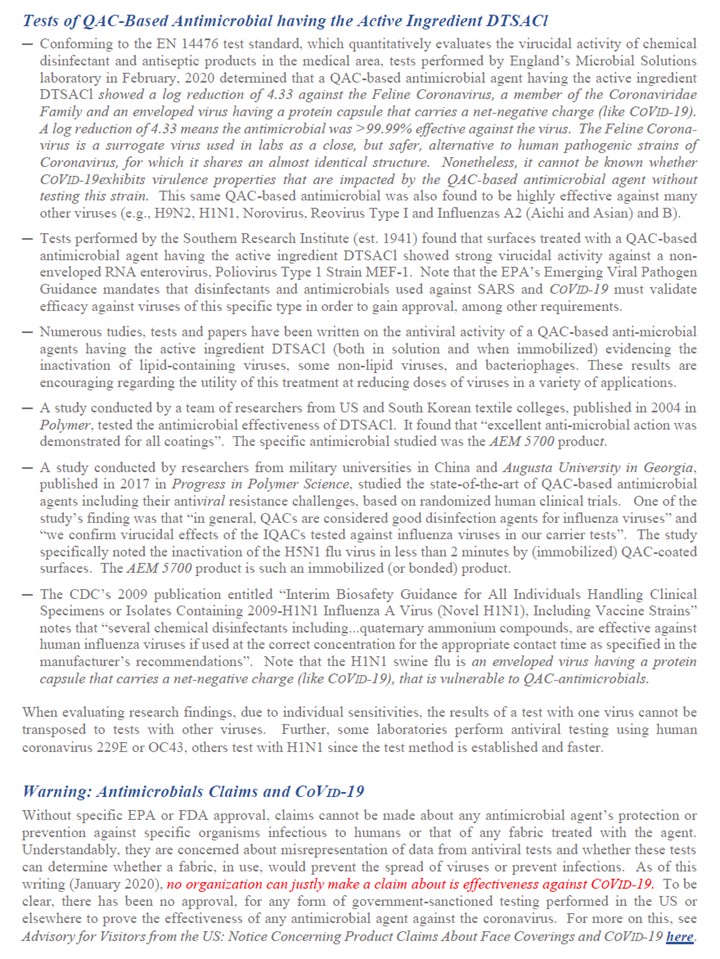Evidence in Support of Triboelectric Air Filter (TAF)
A product is only as good as the materials it is made from; and this is especially true vis-à-vis face coverings. Researchers and chemical safety experts note that the permeability of various materials can vary widely and in unpredictable ways, making it difficult to determine definitively which material is best for a face covering. The type of fabric used, the tightness of the weave, and their exposure to moistening from the wearer’s breath are all factors that impact performance and breathability in unpredictable ways. While we did in fact conduct an exhaustive review of the subject, we defer to the experts in this area.
For eighty years, the world-renown Argonne National Laboratory* has answered the biggest questions facing humanity by redefine the possible. Recently, it refocused its unparalleled scientific facilities and talent to fight against COVID-19. To that end, with University of Chicago* researchers, it conducted an extensive study of the filtration efficiencies of common face covering fabrics. Published in the American Chemical Society’s ACS Nano (April, 2020) journal, its main exhibit is below. It is noteworthy to mention that this study has been referenced by the CDC and in the community face covering specifications issued by several international bodies. Stanford Medicine* researchers conducted similar studies on face coverings .and electrostatic charges.
* The Research Consortium has no relationship with any of these academic/research organizations. References to their research is not intended to imply any form of product endorsement.

Cotton is the most common material used in cloth coverings and different types of cotton exhibit different filtration efficiencies. Thread count is the metric used to denote the relative density (coarseness or fineness) of a fabric and is expressed in threads per inch (TPI). Fabric density, and the number of fabric layers used, directly impact filtration efficiency.
Generally speaking, cotton fabrics having a tighter weave (i.e., higher thread count) do better at physically blocking bacterial and viral droplets. The theory is that particulates trying to cross through the denser fabric membrane will not make it as they will get caught in the gaps and pores. This was in fact borne out by the ACS Nano study, the results of which are presented in the following discussion.
The exhibit below illustrates the filtration efficiencies for cotton with different densities (i.e., different thread counts). The comparison is of three different cotton types: (1) a moderate density (80 TPI) commonly available cotton that sewers often use to make homemade coverings, (2) a high density (600 TPI) cotton fabric and (3) cotton quilt (two 120 TPI cotton layers sandwiching a ∼.5 cm batting of 90% cotton/5% poly/5% other fibers).
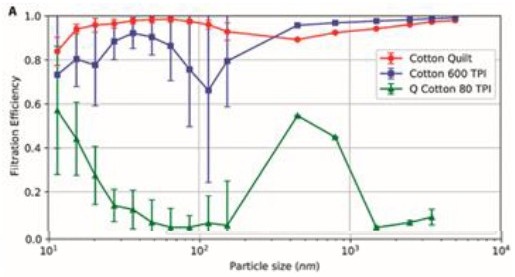
Comparing the cotton fabrics with different thread counts, the 600 TPI cotton is superior having > 65% filtration efficiency at < 300 nm and > 90% at > 300 nm. This tighter woven cotton fabric exhibited outstanding filtration efficiency. By comparison, the single-layer 80 TPI cotton fabric does not perform as well, with filtration efficiencies varying from ∼ 5 to ∼ 55% depending on the particle size. The cotton quilt also provided excellent filtration efficiency across the entire particle size range (> 80% for < 300 nm and > 90% for >300 nm) although it is less breathable. The ACS Nano studyconcluded that both cotton/chiffon and cotton/silk combinations can effectively filter out most viral-sized aerosol particles, at levels that levels that are fairly substantial.
Certain fabrics are known for their electrostatic filtration capability. As discussed in detail elsewhere herein, when rubbed together, or with other fabrics, they develop a charge that electrocutes the virus upon contact.
The exhibit at the right illustrates the filtration efficiency of four fabrics (used in a face covering without any gap) that are known for their excellent electrostatic ability to filter aerosols. They are 1) one layer of natural silk fabric; 2) four layers of natural silk fabric; 3) one layer of flannel fabric, and lastly (4) one layer of chiffon fabric.
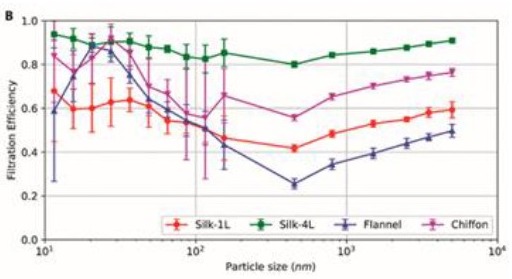
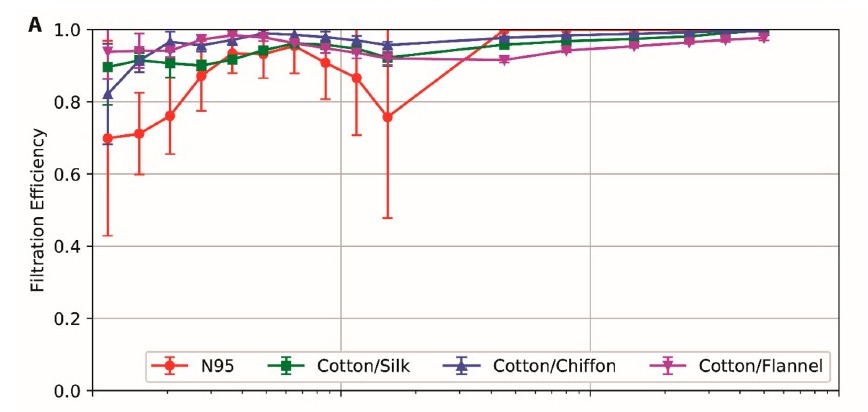
This study clearly indicates silk’s superior performance, by itself, at filtering nanosized particles of all sizes, with more layers increasing its performance. Likewise, chiffon evidenced almost equal superior performance. The exhibit on the left illustrates the filtration efficiency of a fabric combination of 600 TPI cotton and chiffon and cotton and silk as compared to that of the N95 respirator.
It is noteworthy to mention that Cambridge University and Missouri University of Science & Technology researchers performed studies that showed pure cotton had 70% filtration effectiveness against particles that were five times smaller than COVID-19.
Evidence in Support of QAC-Based Antimicrobial Technology
The following provides evidence in support of QAC-based antimicrobial technology and an overview of filtration, antimicrobial and bioburden testing.
